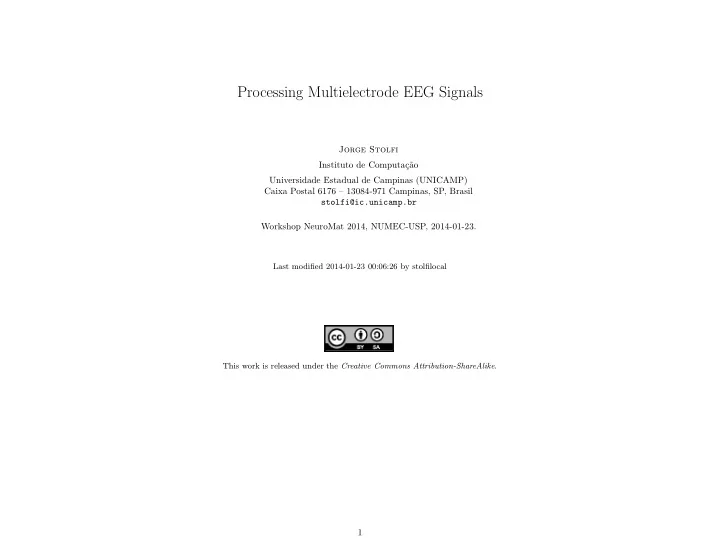

Processing Multielectrode EEG Signals Jorge Stolfi Instituto de Computa¸ c˜ ao Universidade Estadual de Campinas (UNICAMP) Caixa Postal 6176 – 13084-971 Campinas, SP, Brasil stolfi@ic.unicamp.br Workshop NeuroMat 2014, NUMEC-USP, 2014-01-23. Last modified 2014-01-23 00:06:26 by stolfilocal This work is released under the Creative Commons Attribution-ShareAlike . 1
1 Processing Multielectrode EEG Signals Jorge Stolfi Computer Science Institute (IC) State University of Campinas (UNICAMP) Campinas, SP, Brasil stolfi@ic.unicamp.br 2
The Cortex 2 The human cortex (“grey matter”) • About 3 mm thick. • About 0 . 2 m 2 area unfolded. • About 10 11 neurons. 3
The Cortex 3 Columnar organization: • About 10 5 columns. • About 10 6 neurons per column. • Several layers of neurons with distinct morphology. • Axons are generally directed inwards. • Neurons in one column tend to fire simultaneously. • “White matter” is myelinated axons connecting columns. 4
EEG Signals 4 Single neuron firings cannot be detected by EEG: • Neural pulses have high voltages ( 100 mV ) but low energy. • Multipole potentials decay rapidly ( 1 /r 3 or faster). • Too many neurons firing at the same time. • Neuronal pulses last ∼ 1 ms . • Neuron can fire at nearly 200 Hz . 5
EEG Signals 5 Column activity can almost be detected: • Each neuron firing transports a bit of charge down the axon. • Thousands to millions of neurons in a column fire together. • Neurons are generally oriented with axon inwards. Result: significant dipole potential field. 6
EEG Signals 6 Dipole current source: • Return current distrinuted through medium. • Bi-lobe potential distribution. • Potential decays like 1 /r 2 . 7
EEG Signals 7 Pattern expected on scalp for single dipole source: • Spot-and-halo pattern for normal dipole. • Bipolar pattern for parallel dipole. • Potential decays like 1 /r 2 away from maximum. • Amplitude decays with 1 /d 2 . 8
EEG Signals 8 A single column is still too weak to be detected • Detecteble only if many adjcent columns fire together. • There are 10 5 columns but only 10 2 measurements. • At best we can detect activity in 10 2 regions. • Unblurring (Laplacian filtering). 9
The 128-Electrode EEG Signals 9 Signal data: 1. 128 electrodes + reference (zero potential). 127 126 017 021 014 015 025 008 022 009 128 125 032 018 016 010 001 026 002 023 003 011 019 004 033 027 123 122 038 024 124 121 012 005 048 119 043 028 117 120 020 118 034 116 006 039 115 013 112 029 111 035 110 044 114 007 106 040 030 105 109 036 104 045 041 103 108 049 031 080 113 037 087 046 102 042 055 093 047 098 054 079 050 101 053 086 056 051 097 107 052 092 061 078 057 100 062 058 060 085 096 059 091 067 077 072 066 084 063 099 065 090 064 071 076 095 070 083 075 069 089 068 094 074 082 073 088 081 2. Sampling frequency 500 Hz . 3. Typical signal amplitudes < 100 µ V . 4. Large and random offsets > 5000 µ V . 10
The 128-Electrode EEG Signals 10 Raw data for one run: 11
The 128-Electrode EEG Signals 11 Power spectrum: Note: logarithmic power scale. 12
Frequency filtering 12 Test signal: 13
Frequency filtering 13 Butterworth 8-pole filter: Note the ringing artifacts. 14
Frequency filtering 14 Gaussian filter: 15
Frequency filtering 15 Filtered run: 16
Frequency filtering 16 Filtered run: 17
Frequency filtering 17 Power spectrum of filtered run (s013-00209): 18
Frequency filtering 18 Another filtered run: 19
Frequency filtering 19 Another filtered run: 20
Blink patterns 20 Blinks have a well-defined pattern that can be removed with PCA: 21
Pulsating 10 Hz gradient 21 The second PCA component is a pulsating vertical gradient that oscillates irregularly with frequency ∼ 10 Hz : 22
Isolating blinks and 10 Hz gradient 22 23
Isolating blinks and 10 Hz gradient 23 24
Isolating blinks and 10 Hz gradient 24 25
Isolating blinks and 10 Hz gradient 25 26
Conclusions 26 • One should always look closely at the data. • This EEG data will needs a lot of cleanup and processing before it can be used for structural analysis. • Hardware prevention is better than software cure. 27
Recommend
More recommend